The Evolution of the Banking Sector and its Impact on Economic Growth
A Case Study of Iraq (2008-2022)
DOI:
https://doi.org/10.34093/mtc86e36Keywords:
Gross Domestic Product (GDP), Economic sectors, Monetary policy, Number of banksAbstract
This research originated from the problem that Iraq has not achieved desired levels of economic growth during the period (2008–2022), and the banking sector has not contributed to solving this problem. The research aimed to clarify the nature of the relationship between the number of operational banks in Iraq and economic growth. The research relied on the hypothesis suggesting a correlation between the number of operational banks in Iraq and economic growth, but this hypothesis was refuted using quantitative methods. One of the key findings of the research is that an individual's share of the (GDP) depends on several factors, with the development of the banking sector in Iraq not being one of these factors. The absence of a correlation between the number of operational banks in Iraq and an individual's share of the GDP indicates a lack of alignment of the general economic policy goals of the state and making them objectives for the state's economic apparatus. Therefore, it is crucial to unify the economic goals of the state and extend them to all its agencies to become overarching objectives for these entities. Additionally, monitoring the contribution of economic agencies to achieving these goals is essential.
Downloads
Published
Issue
Section
License
The copyright is transferred to the journal when the researcher is notified of the acceptance of his research submitted for publication in the journal.



